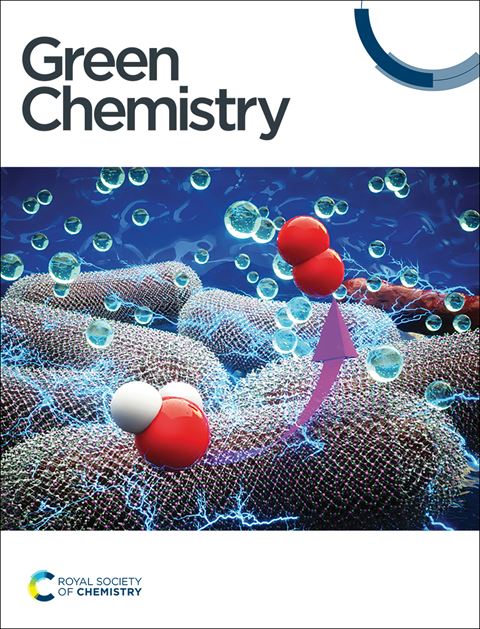Machine learning-driven design of single-atom catalysts for carbon dioxide valorization to high-value chemicals: a review of photocatalysis, electrocatalysis, and thermocatalysis
IF 9.2
1区 化学
Q1 CHEMISTRY, MULTIDISCIPLINARY
引用次数: 0
Abstract
The pressing need for carbon-neutral technologies has driven extensive research into photocatalytic, electrocatalytic, and thermocatalytic CO2 reduction, with highly efficient single-atom catalysts (SACs) due to their atomically dispersed active sites, tunable coordination environments, and well-defined electronic structures. Recent advances in SACs have demonstrated enhanced activity, selectivity and stability through rational design strategies incorporating transition-metal-based single-atom sites, nitrogen-coordinated frameworks, and perovskite-, graphene-, or MOF-supports. Mechanistically, SACs facilitate CO2 activation via optimized CO2 adsorption, electronic-state modulation and selective stabilization of key intermediates, thus promoting tailored product formation. Despite significant progress, challenges remain in understanding the precise electronic effects governing intermediate binding and selectivity and suppressing metal aggregation under operando conditions. This review systematically integrates experimental findings with machine learning (ML)-assisted first-principles calculations, deep learning (DL) frameworks, and density functional theory (DFT) modeling to refine the performances of SACs. ML-driven Bayesian optimization accelerates catalyst discovery by correlating the synthesis parameters with reaction kinetics and thermodynamics. High-throughput experimental validation combined with multi-technique characterization elucidates the structure–activity relationships, providing insights into the electron transfer dynamics, coordination tuning, and catalytic site evolution. The integration of active learning algorithms enables self-optimizing SACs, dynamically adjusting synthesis and reaction conditions for superior selectivity and faradaic efficiency. By bridging predictive modeling with experimental validation, this review presents a comprehensive framework for the rational design of next-generation SACs, paving the way for high-efficiency conversion of CO2 into valuable chemicals. The synergy between AI-driven catalyst discovery and mechanistic elucidation represents a paradigm shift toward viable and selective CO2 valorization strategies.

机器学习驱动的单原子二氧化碳催化高价值化学品的设计:光催化、电催化和热催化的综述
对碳中和技术的迫切需求推动了对光催化、电催化和热催化CO2还原的广泛研究,由于其原子分散的活性位点、可调的配位环境和明确的电子结构,高效的单原子催化剂(SACs)得到了应用。SACs的最新进展表明,通过合理的设计策略,结合过渡金属基单原子位点、氮配位框架和钙钛矿、石墨烯或mof载体,SACs具有更高的活性、选择性和稳定性。从机制上讲,SACs通过优化CO2吸附、电子态调制和关键中间体的选择性稳定来促进CO2活化,从而促进定制产品的形成。尽管取得了重大进展,但在理解控制中间结合和选择性的精确电子效应以及在operando条件下抑制金属聚集方面仍然存在挑战。本文系统地将实验结果与机器学习(ML)辅助的第一性原理计算、深度学习(DL)框架和密度泛函理论(DFT)建模相结合,以改进sac的性能。机器学习驱动的贝叶斯优化通过将合成参数与反应动力学和热力学相关联来加速催化剂的发现。高通量实验验证结合多种技术表征阐明了结构-活性关系,为电子转移动力学,配位调整和催化位点进化提供了见解。主动学习算法的集成使sac能够自我优化,动态调整合成和反应条件,以获得更高的选择性和法拉第效率。通过将预测模型与实验验证相结合,本文为下一代sac的合理设计提供了一个全面的框架,为二氧化碳高效转化为有价值的化学品铺平了道路。人工智能驱动的催化剂发现和机制阐明之间的协同作用代表了向可行和选择性二氧化碳增值策略的范式转变。
本文章由计算机程序翻译,如有差异,请以英文原文为准。
求助全文
约1分钟内获得全文
求助全文
来源期刊

Green Chemistry
化学-化学综合
CiteScore
16.10
自引率
7.10%
发文量
677
审稿时长
1.4 months
期刊介绍:
Green Chemistry is a journal that provides a unique forum for the publication of innovative research on the development of alternative green and sustainable technologies. The scope of Green Chemistry is based on the definition proposed by Anastas and Warner (Green Chemistry: Theory and Practice, P T Anastas and J C Warner, Oxford University Press, Oxford, 1998), which defines green chemistry as the utilisation of a set of principles that reduces or eliminates the use or generation of hazardous substances in the design, manufacture and application of chemical products. Green Chemistry aims to reduce the environmental impact of the chemical enterprise by developing a technology base that is inherently non-toxic to living things and the environment. The journal welcomes submissions on all aspects of research relating to this endeavor and publishes original and significant cutting-edge research that is likely to be of wide general appeal. For a work to be published, it must present a significant advance in green chemistry, including a comparison with existing methods and a demonstration of advantages over those methods.
 求助内容:
求助内容: 应助结果提醒方式:
应助结果提醒方式:


